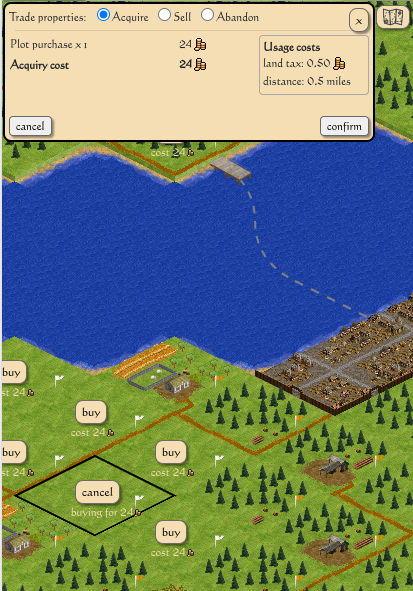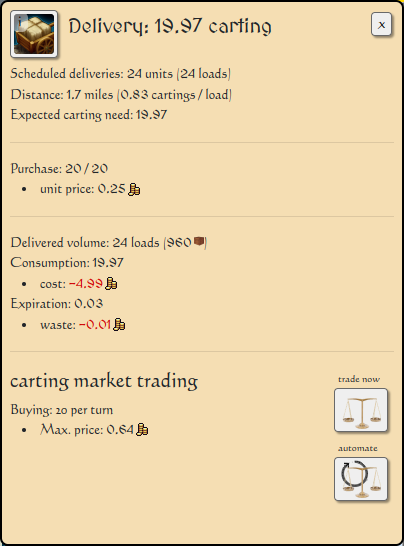Carted into town
Transporting goods over land was expensive in medieval times (or any pre-railroad time for that matter), and if a simulation is to organically generate the human landscape we saw in that era, this is an important element to include.
Anyone who have transported goods over land between towns in Mercatorio will have already experienced this, with waterway transportation often being an order of magnitude more cost effective for a give volume and distance.

The shortest route between these two towns is over land (with some winding to avoid the densest forest), but we’d be way better of shipping the goods along the river. 240 cargo a month may be ok for small and valuable items, but with a single stack of brick taking 20, this is going to be a low throughput trade-route.
Town delivery over land
So transportation between towns is already well simulated, but even within the domain of a town there can be distances of several miles. This is already quite meaningful if you’re pushing a cart of bricks on muddy roads. With the recent introduction of delivery costs and carting service, this is now becoming part of the simulation as well.

We’re looking at a plot near the town to avoid expensive delivery costs for our goods,
this being 4 tiles or 0.5 miles from the center.
… or by ferry
The land across the river is mostly free and we can get a plot with lots of room for expansion and short distance to push the cart, but in return there’s a fee to use that ferry. Again, this may be fine if we’re transporting gold ore or (depending on market conditions) wool, but it’s going to seriously eat into the profits if we’re producing something voluminous or heavy like firewood or bricks.

We’re practically at the ferry landing, so carting is going to be a breeze,
but a ferry fee of 1.22 pence per load might eat into our profits.
Production and delivery
The production screen is now updated with a delivery section where we control the purchasing of the carting service. The unit of this is a standard delivery of a cartload (40 cargo) from 2 miles away.

This logging camp is located 1.7 miles from the town center, meaning we need 20 carting to deliver 24 loads of firewood. The cost of this will be noticeable but probably manageable in most market conditions.

We’re purchasing carting service for 0.25 pence per standard delivery,
costing us 5 per turn to deliver our full production (including the unused service).
Medieval towns were often laid out with sources of firewood and production of heavy construction materials like bricks or timber being located close to the town, while higher value goods like wool, cheese, glass or ores could be farther away.
The aim of Mercatorio is to get these same patterns developing without forcing them with hard-coded rules, but by simulating the actual costs incurred by the production methods and the logistics around them. With this update we have gotten a large step closer to that vision!

